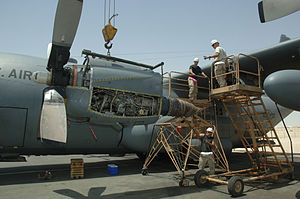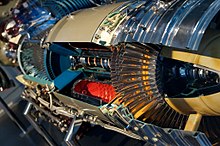Allison T56
| T56 / Model 501 | |
|---|---|

| |
| A T56 mounted on a U.S. Air Force C-130 Hercules receives maintenance. | |
| Type | Turboprop |
| National origin | United States |
| Manufacturer | Rolls-Royce plc
|
| Major applications | |
| Number built | >18,000[2] |
| Developed from | Allison T38 |
| Developed into | Rolls-Royce T406 |
The Allison T56 is an American single-shaft, modular design military
Design and development

The T56 turboprop, evolved from Allison's previous
The T56-A-1 delivered to Lockheed in May, 1953, produced only 3,000 shp (2,237 kW), compared to the required 3,750 shp (2,796 kW) for the YC-130A. Evolution of the T56 has been achieved through increases in pressure ratio and turbine temperature. The T56-A-14 installed on the P-3 Orion has a 4,591 shp (3,424 kW) rating with a pressure ratio of 9.25:1 while the T56-A-427 fitted to the E-2 Hawkeye has a 5,250 shp (3,915 kW) rating and a 12:1 pressure ratio. In addition, the T56 produces approximately 750 lbf (3,336.17 N) residual thrust from its exhaust.[6]
Over the years, there have been a number of engine development versions, which are grouped by series numbers. The Series I collection of derivatives came out in 1954, producing a sea-level static power rating of 3,460 propeller shp (2,580 kW) at a 59 °F (15 °C; 519 °R; 288 K) ambient temperature. Successive engine follow-ups included the Series II, which was introduced in 1958 and had an increased power rating of 3,755 prop shp (2,800 kW), and the Series III, which came out in 1964 and had another power increase to 4,591 prop shp (3,424 kW). The Series II and III derivatives were developed under military component improvement programs (CIP).
The
The T56 Series 3.5, an engine enhancement program to reduce fuel consumption and decrease temperatures, was approved in 2013 for the National Oceanic and Atmospheric Administration (NOAA) WP-3D "Hurricane Hunter" aircraft.
Production of the T56 engine is expected to continue to at least 2026, with the U.S. Naval Air Systems Command (NAVAIR) order in 2019 of 24 additional E-2D Advanced Hawkeyes (AHEs) powered by the T56-A-427A engine variant.[17]
Experimental and non-turboprop uses
The T56/Model 501 engine has been used in a number of experimental efforts, and as something other than a turboprop powerplant. In early 1960, two Allison YT56-A-6 experimental turbine engines without propellers were added next to existing propulsion engines on
In 1963, an
During the late 1960s, the U.S. Navy funded the development of the T56-A-18 engine, which introduced a new gearbox compared with the early gearbox on the T56-A-7.
Following the HLH program cancellation, Allison decided in early 1976 to apply the XT701 engine technology into a new industrial gas turbine product, the 570-K. The industrial engine, which entered production in the late 1970s, was derated to 7,170 shp (5,350 kW) and adapted for marine, gas compressor, and electrical power generation variants.[27] The only major changes made for the 570-K were the elimination of compressor bleed air and replacing the XT701's titanium compressor case with a steel case. The 570-K was then adapted to the 6,000 shp (4,500 kW) 501-M78B demonstration engine, which Lockheed flew on a Grumman Gulfstream II as part of the NASA Propfan Test Assessment Program in the late 1980s. The 501-M78B had the same 13-stage compressor, combustor, 2-stage gas producer turbine, and 2-stage free power turbine used on the XT701 and 570-K, but it was connected through a 6.797 reduction ratio gearbox to a 9 ft diameter (2.7 m) Hamilton Standard single-rotation propfan, containing propfan blades that were swept back 45 degrees at the tips.[29]
Variants
The T56 has been developed extensively throughout its production run, the many variants are described by the manufacturer as belonging to four main series groups.
Initial civil variants (Series I) were designed and produced by the Allison Engine Company as the 501-D and powered the Lockheed C-130 Hercules. Later variants (Series II, III, and IV) and the Series 3.5 engine enhancement kit gave increased performance through design refinements.
Further derivatives of the 501-D/T56 were produced as turboshafts for helicopters including a variant designated T701 that was developed for the canceled Boeing Vertol XCH-62 project.
Applications
Specifications (T56 Series IV)
Data from Rolls-Royce.[30]
General characteristics
- Type: Turboprop engine
- Length: 146.1 in (3,710 mm)
- Diameter: 27 in (690 mm)
- Dry weight: 1,940 lb (880 kg)
Components
- Compressor: 14 stage axial flow
- cylindrical flow-through
- Turbine: 4 stage shared load
- Fuel type: aviation gasoline (grade 115/145 or lower)[31]
Performance
- Maximum power output: SLS, 59 °F (15 °C), max power: 5,912 shp (4,409 kW) (torque limited to 5,250 shp (3,910 kW)); 25,000 ft altitude (7,600 m), Mach 0.5, max continuous power: 3,180 shp (2,370 kW)[9]
- Turbine inlet temperature: 860 °C (1,580 °F)
- Fuel consumption: 2,412 lb/h (1,094 kg/h)
- Power-to-weight ratio: 2.75 shp/lb (4.52 kW/kg)
See also
Related development
Comparable engines
- Bristol Proteus
- Ivchenko AI-20
- Lycoming T55
- Napier Eland
- Rolls-Royce Tyne
Related lists
References
- ^ Proc, Jerry. "CP-140 Aurora". Radio communications and signals: Intelligence in the Royal Canadian Navy. Retrieved 25 August 2020.
- Rolls-Royce plc. Retrieved 25 August 2020.
- ^ a b c d "Global Security T56". www.globalsecurity.org. Retrieved 1 November 2012.
- Rolls-Royce plc. Archived from the original(PDF) on 7 February 2013. Retrieved 25 August 2020.
- ISSN 0015-3710. Archived from the originalon 27 December 2014.
- ^ McKinnon, Phillip (September 2004). "The Rolls-Royce Allison T56 is fifty" (PDF). New Zealand Aviation News. Archived from the original (PDF) on 21 October 2014. Retrieved 2 November 2013.
- ^ OCLC 7344649118.
- OCLC 42343144.
- ^ OCLC 4434363138.
- Rolls-Royce plc. Archived from the original(PDF) on 17 February 2013. Retrieved 2 November 2012.
- Smithsonian National Air and Space Museum. "Propeller, variable-pitch, 6-blade, Dowty R391". Retrieved 4 August 2020.
- ^ "NOAA 'Hurricane Hunters' first to get T56 series 3.5 engine enhancement". Aero News. 14 November 2013. Retrieved 1 December 2013.
- ^ Drew, James (10 September 2015). "USAF approves production of Rolls-Royce T56 Series 3.5 upgrade". FlightGlobal. Retrieved 11 August 2020.
- ^ "US approves Rolls-Royce's T56 Series 3.5 engine upgrade for C-130H fleet". Airforce Technology. 9 July 2014. Retrieved 16 February 2023.
- ^ Trevithick, Joseph (8 January 2018). "USAF eyeing new props and upgraded engines to breathe extra life into old C-130Hs". The War Zone. The Drive. Retrieved 4 August 2020.
- AINonline. Retrieved 4 August 2020.
- AINonline. Retrieved 9 September 2020.
- OCLC 50447726.
- ISSN 0005-2175.
- ^ Zigmunt 1997, p. 127.
- ^ Allison Industrial Gas Turbines 1983.
- OCLC 8518878647.
- OCLC 8518954720.
- ^ The 1969 aerospace year book (PDF). Aerospace Industries Association of America (AIA). 1969. p. 52.
- ISSN 0004-2560.
- ISSN 0148-7191.
- ^ )
- OCLC 227450087. alternate url
- OCLC 891598373. alternate url
- Rolls-Royce plc. 2003. pp. 8-1 to 8-24.
- U.S. Department of Transportation(DOT). 25 July 2013. Retrieved 11 August 2020.
Bibliography
- Zigmunt, Joan Everling (June 1997). Allison, the people and the power: A pictorial history. Turner Publishing Company. OCLC 37537128.
- Sonnenburg, Paul; Schoneberger, William A (1990). Allison power of excellence 1915-1990. OCLC 22964244.
- Allison Gas Turbine Operations (August 1983). "Allison industrial gas turbines 501-K, 570-K" (PDF). International Power Technology. Retrieved 7 August 2020.
- Yaffee, Michael L. (12 August 1974). "New family of Allison engines evolving". Aeronautical engineering. ISSN 0005-2175.
- Aircraft Industries Association, Inc. (1958). 1957-1958 aircraft year book (PDF) (39th ed.). American Aviation Publications, Inc. Archived from the original (PDF) on 22 January 2022. Retrieved 12 August 2020.
- Hotz, Robert (12 December 1955). "Allison moves to boost its airline sales". Management. ISSN 0005-2175.
